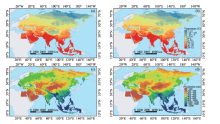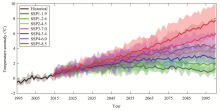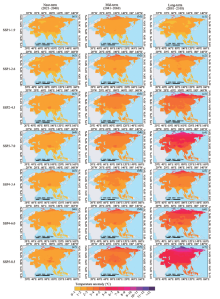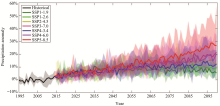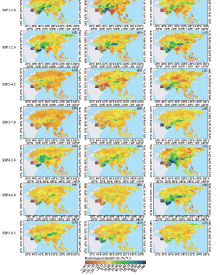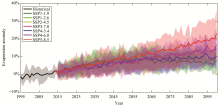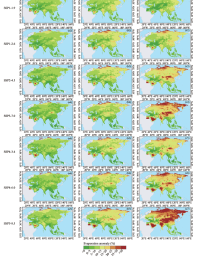Sciences in Cold and Arid Regions ›› 2020, Vol. 12 ›› Issue (6): 389–403.doi: 10.3724/SP.J.1226.2020.00389
Simulation and projection of climate change using CMIP6 Muti-models in the Belt and Road Region
YanRan Lü1,Tong Jiang1( ),YanJun Wang1,BuDa Su1,JinLong Huang1,Hui Tao2
),YanJun Wang1,BuDa Su1,JinLong Huang1,Hui Tao2
- 1.Institute for Disaster Risk Management/ School of Geographical Sciences, Nanjing University of Information Science & Technology, Nanjing, Jiangsu 210044, China
2.State Key Laboratory of Desert and Oasis Ecology, Xinjiang Institute of Ecology and Geography, Chinese Academy of Sciences, Urumqi, Xinjiang 830011, China
|
Beck HE, Zimmermann NE, Mcvicar TR, et al., 2018. Present and future Köppen-Geiger climate classification maps at 1-km resolution. Scientific Data, 5: 180214. DOI: 10.1038/sdata.2018.214.
doi: 10.1038/sdata.2018.214 |
|
| Chen HP, Sun JQ, Lin WQ, et al., 2020. Comparison of CMIP6 and CMIP5 models in simulating climate extremes. Science Bulletin, 65(17): 1415-1418. | |
| Cooke RU, Warren A, Goudie A, 1993. Desert Geomorphology. 2nd edition. London: UCL Press, pp. 10-20. | |
|
Coumou D, Rahmstorf S, 2012. A decade of weather extremes. Nature Climate Change, 2(7): 491-496. DOI: 10.1038/nclimate1452.
doi: 10.1038/nclimate1452 |
|
| IPCC, 2013. Climate change 2013: The physical science basis. Contribution of Working Group I to the Fifth Assessment Report of IPCC the Intergovernmental Panel on Climate Change. United Kingdom and New York, NY, USA: Cambridge University Press. | |
| IPCC, 2014. Climate Change 2014: impacts, adaptation, and vulnerability. Contribution of Working Group Ⅱ to the Fifth Assessment Report of the Intergovernmental Panel on Climate Change. Cambridge and New York, Cambridge University Press. | |
| IPCC, 2018. Special Report1.5 (SR15) Summary for Policy Makers. Korea Incheon. | |
|
Jiang T, Tan K, Wang YJ, et al., 2020. Spatial-temporal variation of meteorological disasters in the "Belt and Road" regions. Science & Technology Review, 38(8): 57-65. DOI: 10.3981/j.issn.1000-7857.2020.08.007.
doi: 10.3981/j.issn.1000-7857.2020.08.007 |
|
|
Kriticos DJ, Webber BL, Leriche A, et al., 2012. CliMond: global high-resolution historical and future scenario climate surfaces for bioclimatic modelling. Methods in Ecology and Evolution, 3: 53-64. DOI: 10.1111/j.2041-210X. 2011.00134.x.
doi: 10.1111/j.2041-210X. 2011.00134.x |
|
| Li H, Sheffield J, Wood EF, 2010. Bias correction of monthly precipitation and temperature fields from Intergovernmental Panel on Climate Change AR4 models using equidistant quantile matching. Journal of Geophysical Research, 115: D10101. | |
|
Lü YR, Jiang T, Tao H, et al., 2020. Spatial-temporal patterns of population exposed to the extreme maximum temperature events in the Belt and Road regions. Science & Technology Review, 38(16): 68-79. DOI: 10.3981/j.issn.1000-7857.2020.
doi: 10.3981/j.issn.1000-7857.2020 |
|
|
O'Neill BC, Kriegler E, Ebi KL, et al., 2017. The roads ahead: narratives for shared socioeconomic pathways describing world futures in the 21st century. Global Environmental Change, 42: 169-80. DOI: 10.1016/j.gloenvcha.2015. 01.004.
doi: 10.1016/j.gloenvcha.2015. 01.004 |
|
|
O'Neill BC, Kriegler E, Riahi K, et al., 2014. A new scenario framework for climate change research: the concept of Shared Socioeconomic Pathways. Climatic Change, 122(3): 387-400. DOI: 10.1201/b20720-17.
doi: 10.1201/b20720-17 |
|
|
Peel MC, Finlayson BL, McMahon TA, 2007. Updated world map of the Köppen-Geiger climate classification. Hydrology and Earth System Sciences, 11: 1633-1644. DOI: 10. 5194/hess-11-1633-2007.
doi: 10. 5194/hess-11-1633-2007 |
|
|
Su BD, HuangJL, Fischer T, et al., 2018. Drought losses in China may triple between 1.5 °C and2.0 °C warming: policy hints of shared socio-economic pathways. PNAS, 115(42): 10600-10605. DOI: 10.1073/pnas.1802129115.
doi: 10.1073/pnas.1802129115 |
|
| Wang B, Zhou TJ, Yu YQ, et al., 2018. A perspective on earth system model development. Acta Meteorologica Sinica, 66(6): 857-869. | |
|
Wang HJ, Tang GL, Chen HS, et al., 2020. The Belt and Road region climate change: facts, impacts and possible risks. Transactions of Atmospheric Sciences, 43(1): 1-9. DOI: 10. 13878/j.cnki.dqkxxb.20191110003.
doi: 10. 13878/j.cnki.dqkxxb.20191110003 |
|
| Wood AW, Leung LR, Sridhar V, et al., 2004. Hydrologic implications of dynamical and statistical approaches to downscaling climate model outputs, Climatic Change, 62: 189-216. | |
| World Meteorological Organization (WMO), 2019. The Global Climate in 2015-2019. Switzerland: WMO. | |
|
Wu SH, Liu LL, Liu YH, et al., 2018. Geographical patterns and environmental change risks in terrestrial areas of the Belt and Road. Acta Geographica Sinica, 73(7): 1214-1225. DOI: 10.11821/dlxb201807003.
doi: 10.11821/dlxb201807003 |
|
| Zhang JY, Zhuang YH, Li K, 2019. Future Projections of Climate Change over Major Regions of Belt and Road. China Meteorological Press, Beijing, pp. 2-5. | |
|
Zho ZC, Luo Y, 2016. Design of CMIP6. Climate Change Research, 12(3): 258-260. DOI: 10.12006/j.issn.1673-1719. 2016.066.
doi: 10.12006/j.issn.1673-1719. 2016.066 |
|
|
Zhou BT, Xu Y, Han ZY, et al., 2020. CMIP5 projected changes in mean and extreme climate in the Belt and Road region. Transactions of Atmospheric Sciences, 43(1): 255-264. DOI: 10. 13878 /j.cnki.dqkxxb.20191125009.
doi: 10. 13878 /j.cnki.dqkxxb.20191125009 |
|
| Zhou J, Jiang T, Wang YJ, et al., 2020. Spatiotemporal variations of aridity index over the Belt and Road region under the 1.5 °C and2.0 °C warming scenarios. Journal of Geographical Sciences, 30(1): 37-52. |
| No related articles found! |





